
Haruka Watanabe
Producer
Creative & Knowledge Promotion Center
Dentsu Inc.
Wouldn’t you agree that to communicate a new idea, it is more effective to provide an experience rather than trying to explain it with a written proposal?
We introduce “prototyping”, a presentation method that shares an idea through experience.
An event for the young creatives in Dentsu called “PROTOTYPING HACKATHON by Dentsu Lab Tokyo” took place on March 4, 2022.
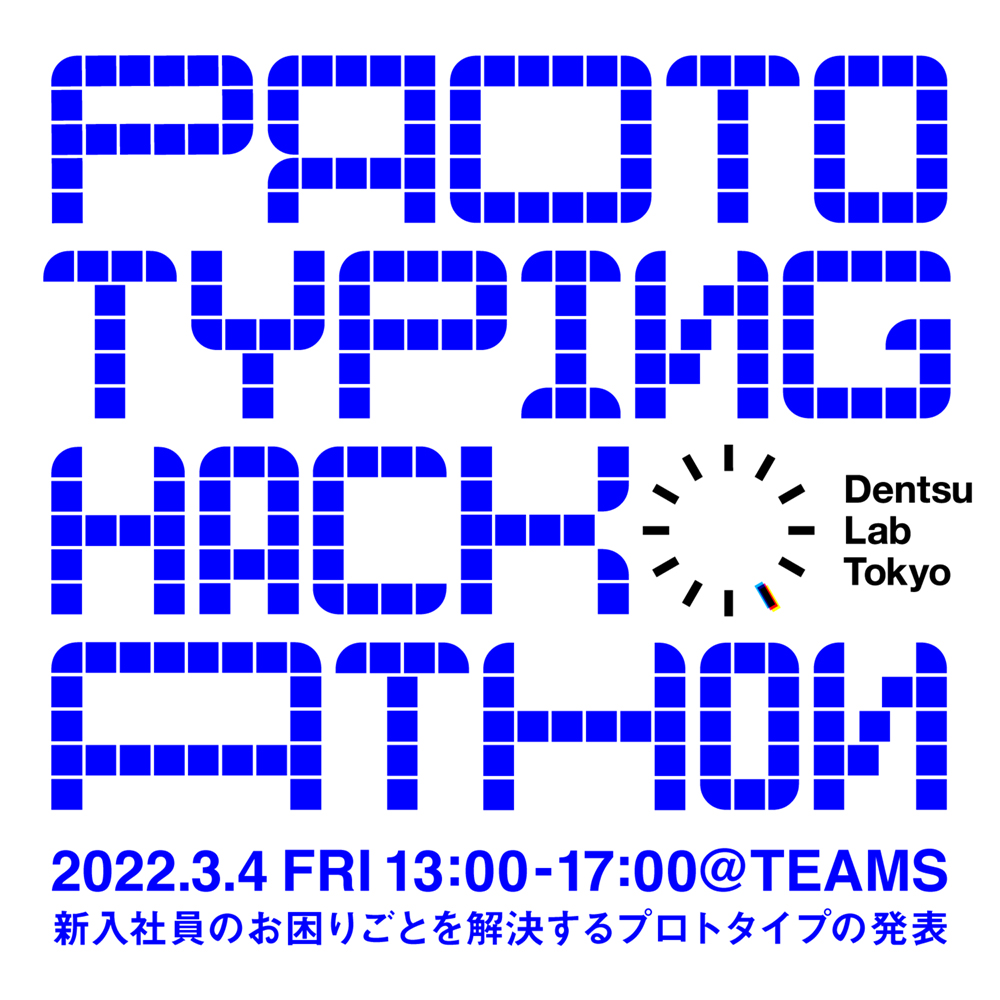
| ※ | Prototyping is a method used mainly in technology-related areas. In the early stage of product development, a test production of a model that can actually be operated is used to confirm its functions and obtain evaluation from users. |
| ※ | Hackathon is a coined word combining ‘hack’ and ‘marathon’. An app or a service is developed within a certain time period, and the results are presented in a competition event called a ‘hackathon’. |
The theme: “Our mission is to solve issues and concerns that rookies may face in the times ahead.”
Twenty-six young creators were split up into six teams, and under the technical mentoring of “Dentsu Lab Tokyo”, digital creators team in Dentsu, they took on various challenges over a one-and-a-half-month period.
Haruka Watanabe, who is in charge of human resources and knowledge development in the creative field, gives a report on the hackathon which she helped organize, and explains the benefits of experiencing ideas through prototyping using the hackathon as an example.
‘Unknown experiences’ cannot be conveyed in a proposal. Here is why prototyping is in demand.
In recent years, the challenges we face in business have become diverse.
The solutions proposed by the advertising industry also go beyond mass advertising, expanding into areas applying technology, such as service design, product development, and AR or VR experiences.
However, ideas leveraging technology often involve ‘unknown experiences’ which make it more difficult for clients and team members to gain a clear image of the finished form just from reading a proposal.
That is why creating a prototype that visualizes the final form has become a preferred method to confirm the image and operation during the production process.
What kind of ideas can be ‘experienced’ with what type of prototypes? Let’s take a look at six prototypes produced by the young creators in Dentsu.
| (*1) | In 2019 Dentsu added ‘digital creatives’ as a new category for people they hire, and creators with diverse skills have joined since then. The digital creative staff played a central role in planning and organizing the recent hackathon. Related article (in Japanese): “The reason why we promote ‘creative x technology’ in Dentsu” |
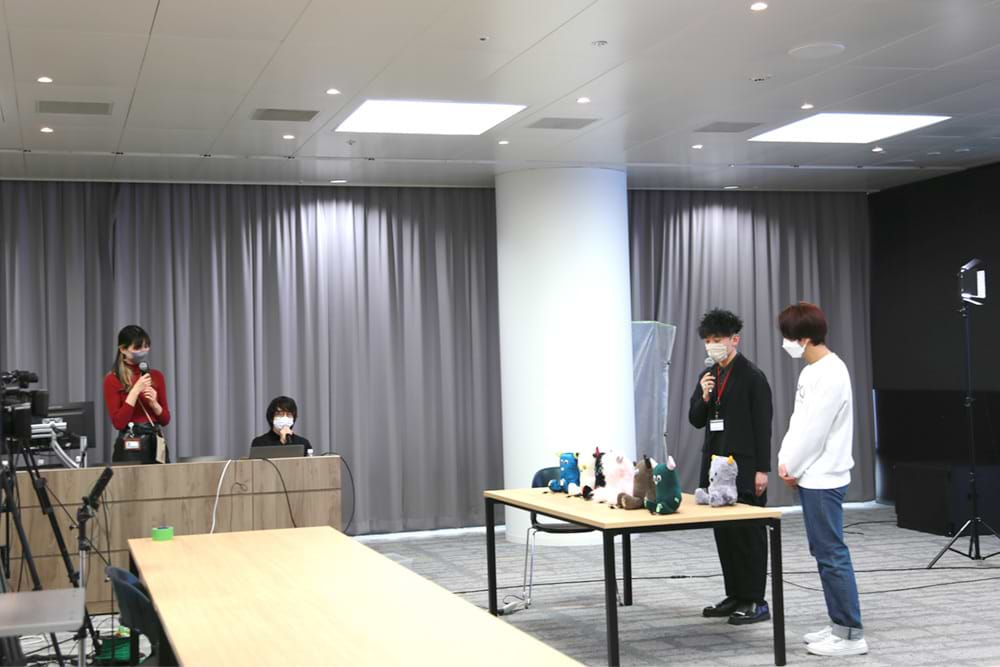
■Prototype 1
Team “Team Higashi-shimbashi 1-chome”
What flavor is your e-mail? “Mail-kake” will change your business e-mails to a flavorful furikake seasoning.
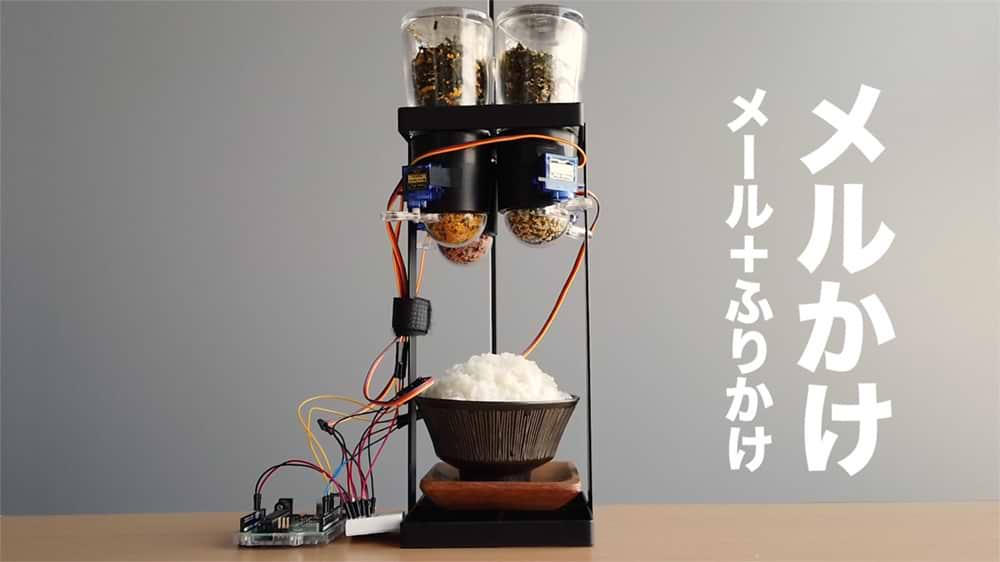
With an increased frequency of working from home, people find themselves communicating more often through e-mail. New employees especially have endless problems with e-mails.
“I don’t understand the intent behind the e-mail I received.”
“Do I sense a bit of anger…?”
“Mail-kake” is a system devised to make e-mail communications positive.
Each time you receive an e-mail, the emotion behind the main text is analyzed and the degree of positive emotion is rated using AI. Depending on the amount of positive emotion, one of the furikake (flavored granular condiment usually sprinkled on rice) types, such as ‘mild egg flavor’, ‘relaxing salmon flavor’, ‘salty red shiso flavor’, or ‘acrid wasabi flavor’, comes out. At the end of the day, the various degrees of positive emotion are combined and presented as today’s total, and you can sprinkle the ‘Mail-kake’ on top of a bowl of rice and enjoy eating it.
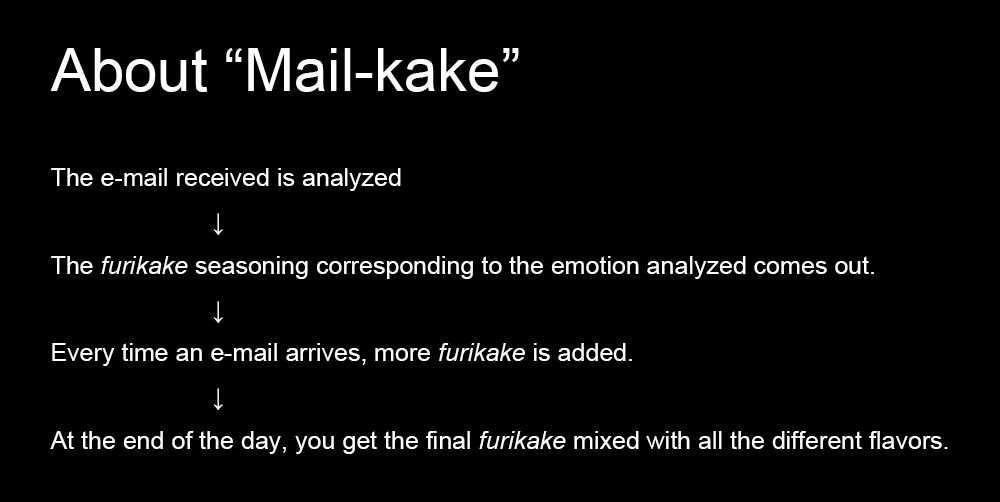
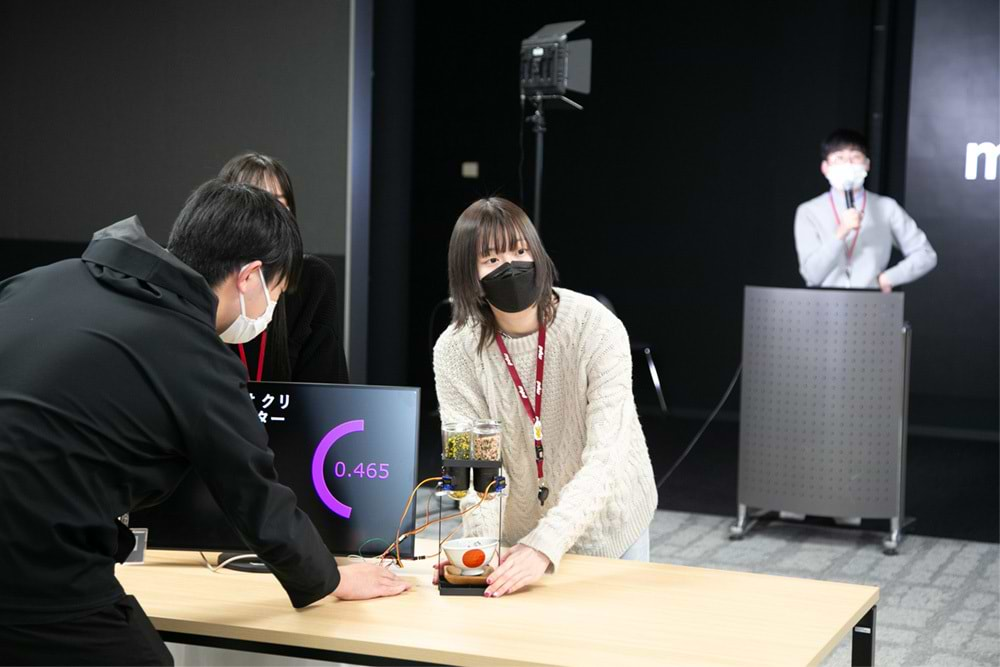
“It wasn’t easy to combine the ‘soft’ aspect of emotion analysis and the ‘hard’ aspect of the furikake flavors, but it was evident that development of ideas start by giving form to the idea rather than explaining it on paper.”
Team: Team Higashi-shimbashi 1-chome
Planner/software engineer: Maya Atsuki
Planner/hardware engineer: Kentaro Tsuji
Planner/video: Yuri Mitsuhashi
Planner: Hiroshi Miyamura, Takahiro Hasegawa
■Prototype 2
Team “O-WAY”
Working remotely becomes a moment of relaxation. Moblin, the next generation mouse you can keep as a pet.
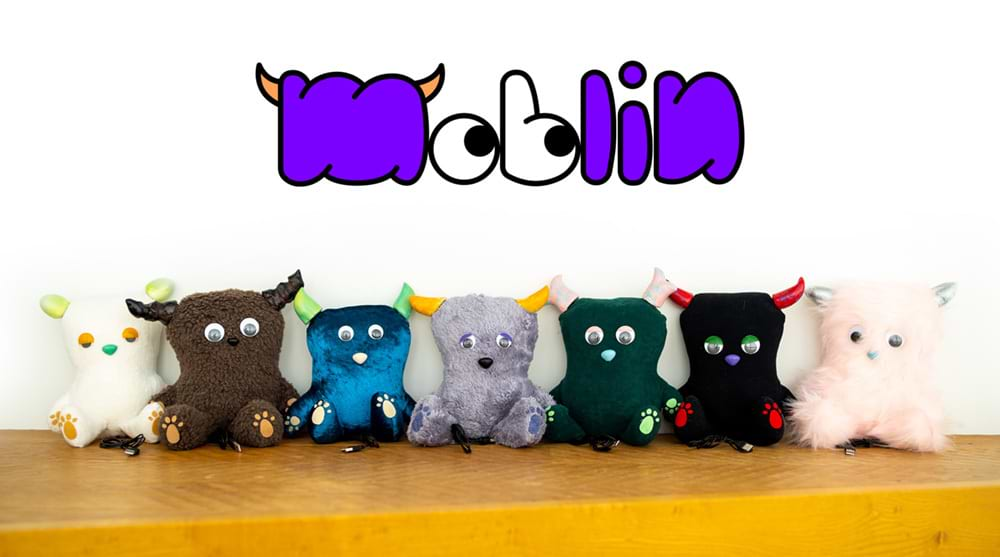
Rookie employees can feel isolated and alone doing everything online, from meetings to general work and communication. To reduce the stress that can build up, we introduce “moblin”, the mouse you can keep as a pet.
There is a wheel embedded in moblin’s head. When you pat moblin on the head, you can scroll up or down on your computer screen. A button is located on moblin’s left and right palm, and you can shake hands with moblin for a right or left click. The horn on moblin’s head comes off and can be combined with any moblin body part you like to create your own unique moblin.
The most time and effort was spent on moblin’s design.
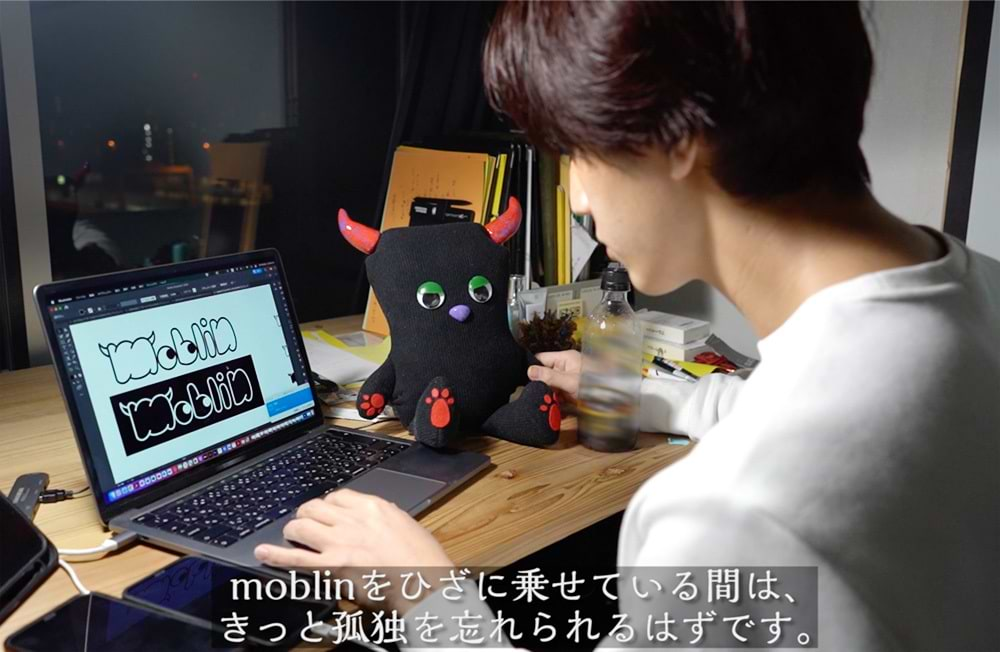

“When our team was sharing our day to day anxieties, we identified the feeling of ‘loneliness’ as an issue we all face. The team worked on prototypes of different ‘cute’ images, and we took our time to create the ideal character.”
Team: O-WAY
Communication planner: Shun Onozawa
Copywriter: Hiina Abe
Art director: Ryohei Yabusaki
Planner: Kunihiro Watanabe
■Prototype 3
Team “80 (Hachimaru)”
“Uppun Sukkiri Paper” (Paper that wreaks your anger) helps get rid of frustration or anger built up from e-mail communication.

“Whether you ask or not, you’ll get yelled at anyway.”
“You get a different story from different people.”
“Uppun Sukkiri Paper”, a product that lets off your steam after you feel frustrated from e-mail communication.
It’s easy to use. Take the e-mail text that ticked you off and send it from your computer to the paper holder. Pull out the toilet paper and that same text is printed on it. All you have to do is use it and flush it down the toilet.
The product was designed to help rookie employees working during the COVID pandemic to have a stress-free working environment. We also hope it would serve as an opportunity for people to choose words more carefully before sending e-mails.

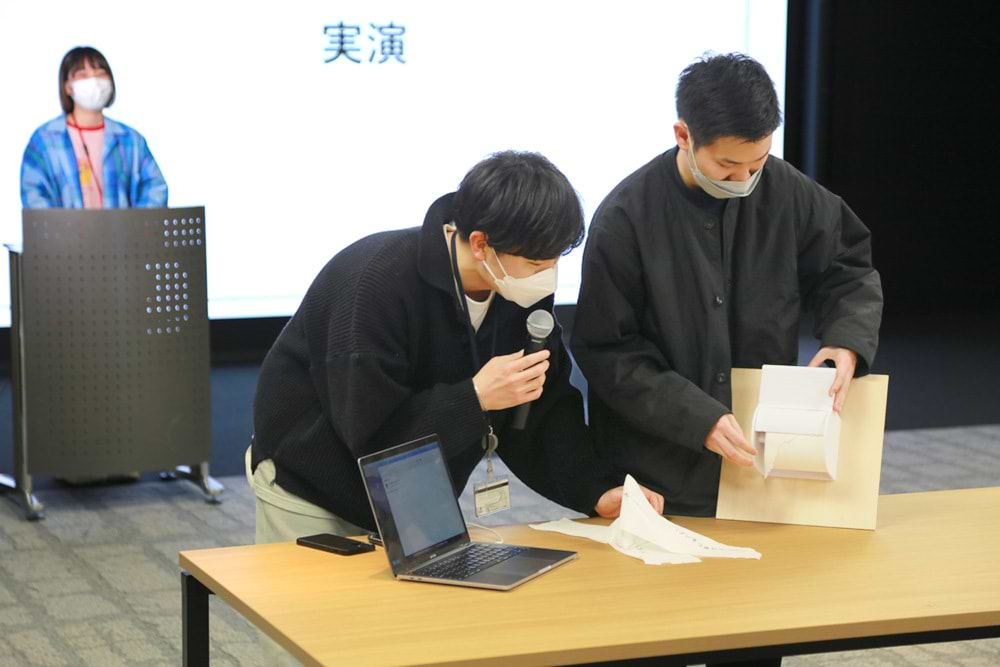
“The idea came to us when we were discussing various issues related to working remotely. Having the real product to complement a written plan or proposal was really convincing, and we also realized it could lead to new ideas.”
With the suggestion of a Dentsu employee who saw the presentation video, the “Uppun Sukkiri Paper” was placed in Dentsu Group booth at the “Tokyo Rainbow Pride 2022” exhibition. This was a good example of a prototype that became the driver to help an idea take shape.
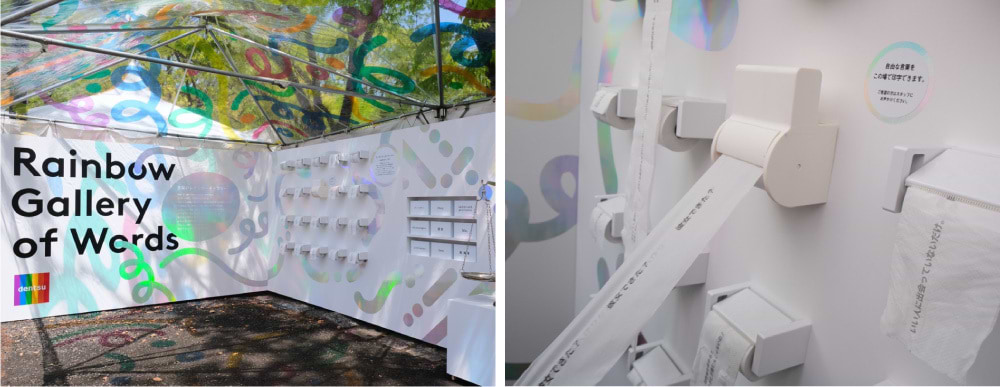
Team: 80 (Hachimaru)
Planner/copywriter: Masashi Araki
Art director/planner: Haruka Sekiguchi
Planner/designer: Sakurako Hasama
Planner/strategist: Kosei Hirata
■Prototype 4
Team “Result of Hattori Operating for X Amount of Hours”
You won’t have to worry anymore if your boss suddenly dumps unreasonable work on you. “Hokyuki” (replenisher) is a partner you can count on when it matters.
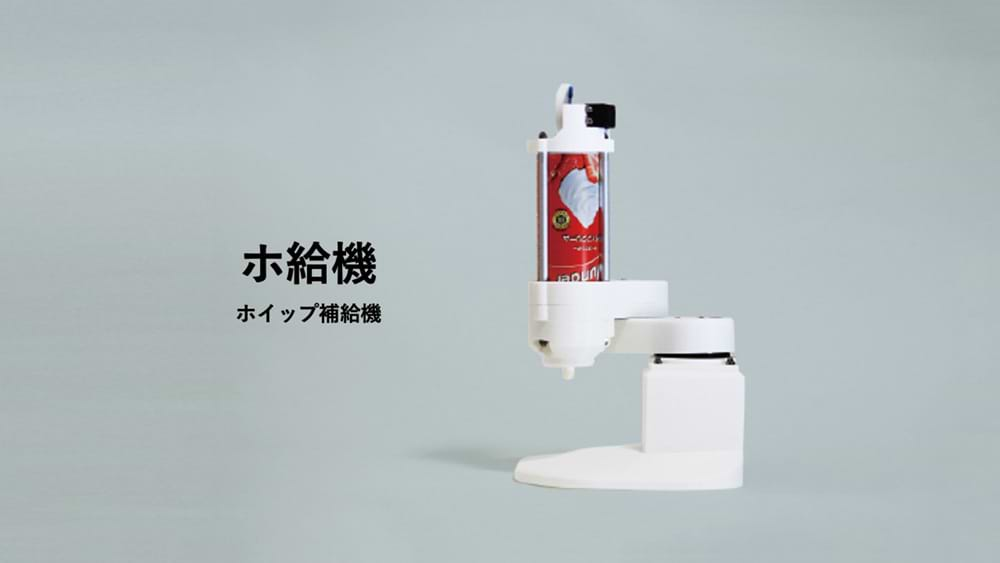
We thought that the most serious issue for rookie employees today is to deal with isolation caused by remote work.
However, when you’re on the job, sometimes you are suddenly told to give a presentation. That’s just how it works in the real world. At times like that, it would be great to have a partner who could help you out.
So we decided to develop a robot that can be by your side and reduce your anxiety. A smartwatch measures your pulse and when it detects that you are feeling tense or anxious, the “Hokyuki” robot writes the word ‘people’ on the palm of your hand to help you relax. (There is a traditional spell used in Japan to overcome stage fright – you write the word ‘people’ on your palm and pretend to swallow it. It is a spell you cast when you feel nervous to speak or perform in front of a crowd.)
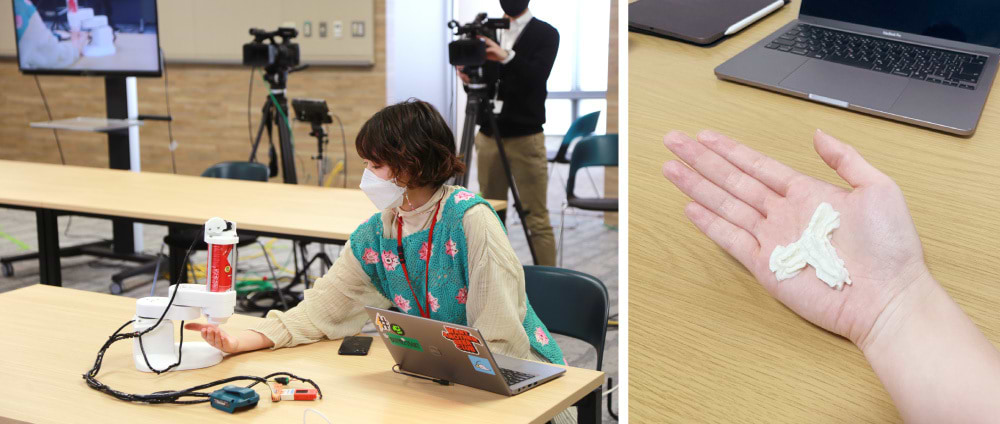
“Creating a prototype helped share the image better and we could discuss the product in more detail. Based on the prototype, we repeated the process of discussing and modifying until we had a total of five prototypes, and we finally decided on the current model.”
Team: Result of Hattori Operating for X Amount of Hours
Art director: Takanori Mamada
Planner: Youli Zhou
Planner: Taro Kimura
Planner: Shuhei Seto
Engineer: Shoki Hattori
■Prototype 5
Team “ShaPure” (“Sha” stands for 斜 where the team name implies a somewhat defiant attitude but in reality pure-minded)
“Nyaisu”, a chair (isu) that lets you know the best timing to speak to your senior colleague. (“Nya” is Japanese for “meow”.)
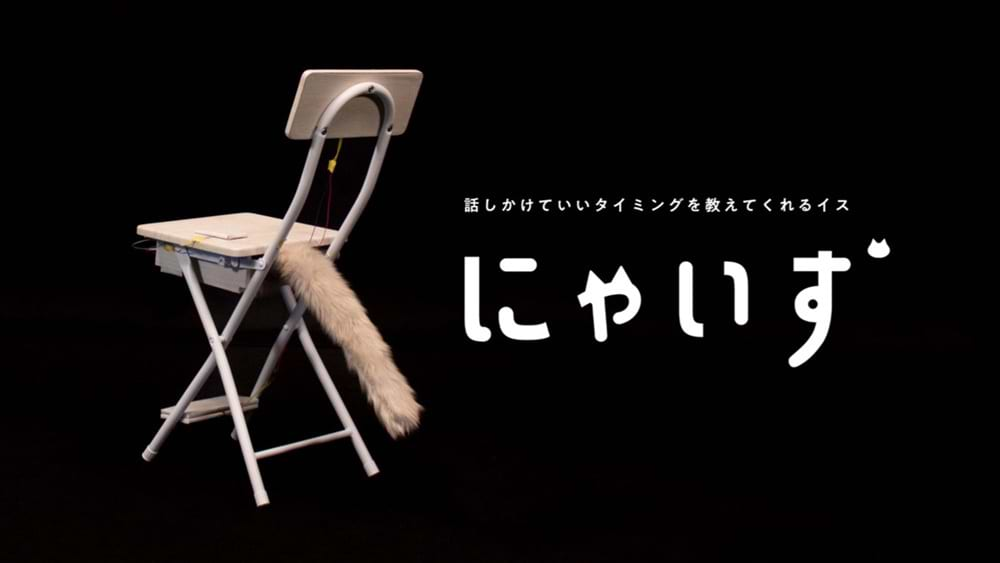
”I have no idea when the best timing is to speak to my senior colleague.”
This problem can be solved with “Nyaisu”, a robot chair with a cat’s tail.
The tail wags according to the degree of concentration of the person sitting in the chair. For example, when the person is focusing, the tail goes straight up; when the person is relaxed, the tail hangs downward. So it is easy to tell when it is the right timing to speak to that person.
The pressure sensors (three pressure points) measure how the person is sitting, and based on that data, two motors move the tail vertically and horizontally to express three patterns of moods: normal, focused, or relaxed.
The wagging tail lets you subtly know your senior colleague’s mood without disrupting his/her thoughts or work. A lot of work went into the design of the fluffy tail to ensure it moved in a cute way.
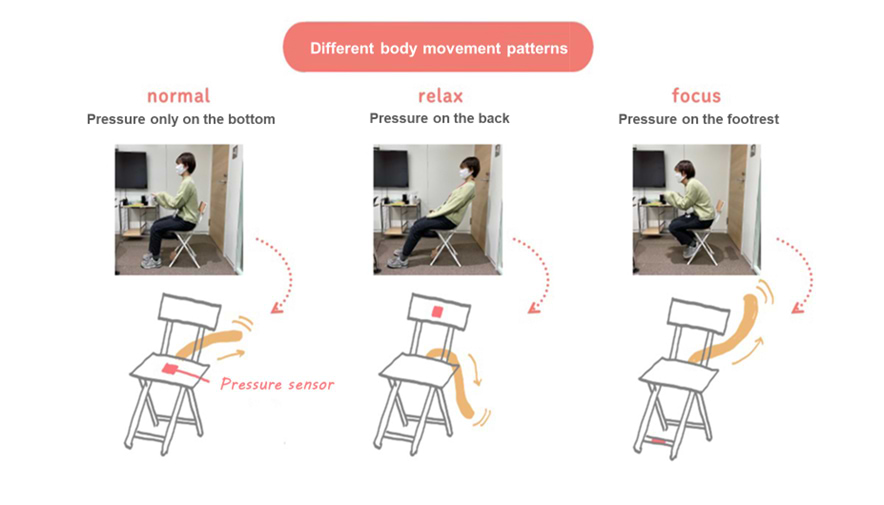

“No one on the team had experience making electronic devices. We spent a month and a half studying, producing, and learning from experts to develop our idea. Ideas can expand and go in a million different directions, but we discovered that we could narrow it down by actually creating a prototype with our hands and demonstrating its operation.”
Team: ShaPure
Planner: Tatsuya Honda
Art director: Yui Miyamoto
Copywriter: Mina Sugioka
UI/UX designer: Tamami Obuchi
■Prototype 6
Team “Don’t Know How to Use the Budget”
Experience how it feels to be a hero/heroine in a movie! The “Romantic Elevator” changes a chance meeting to a predestined encounter.
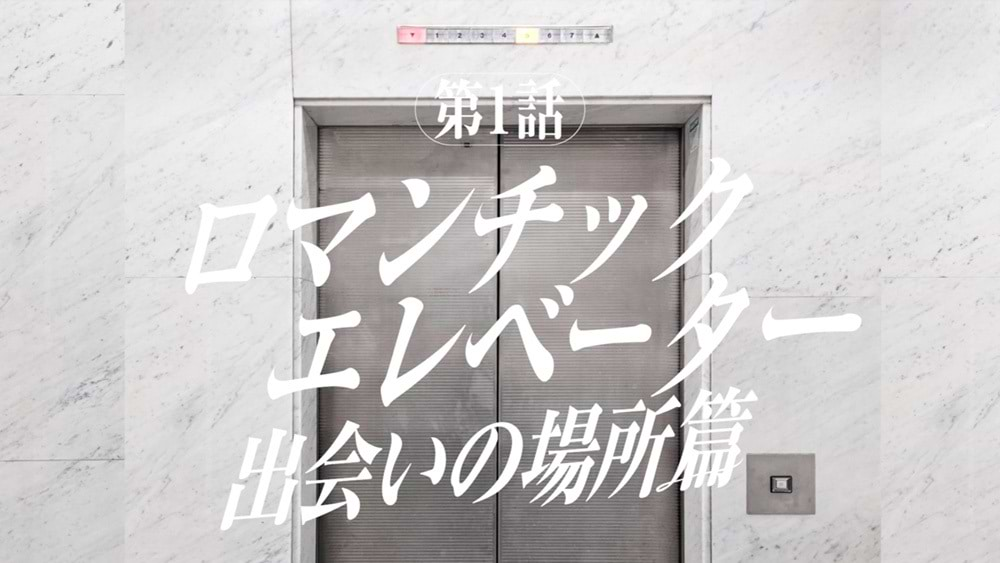
The COVID-19 pandemic stripped us of ‘encounters sparked by coincidence’, and communication among colleagues at work has become sparse. This is a serious issue for rookie employees.
The “Romantic Elevator” is the key to solving this problem. When a webcam detects that there are two passengers in the elevator, various voices are delivered through the speaker, making the encounter in the elevator something special.
There are 11 types of voices in total, including love, horror, and death game. The narrative would make people chuckle or it would make people want to talk to someone out of embarrassment.
We experimented many times in the elevator at home and at work, and we also spent a lot of work on creating the right atmosphere and developing the case video.
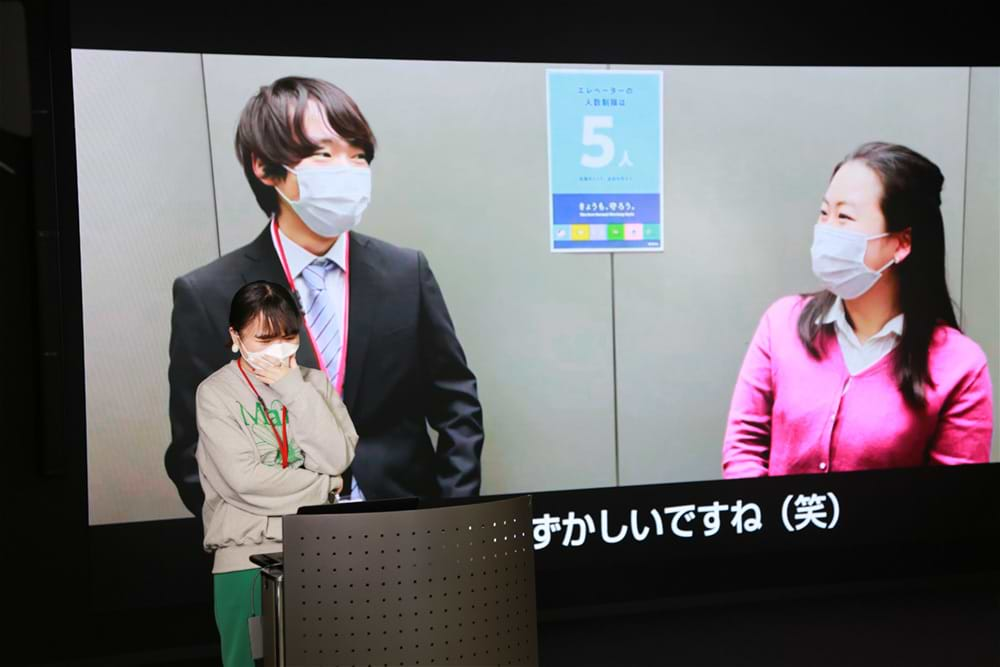
“I was impressed with my colleagues’ range of expertise and the high quality of the output in the last week. Co-workers who participated in the test play told me that they would gladly come to work every day for this. That comment boosted my motivation.”
Team: Don’t Know How to Use the Budget
Planner/movie editor: Enho Hayashi
Planner/CG editor: Kenichiro Tanaka
Technologist: Kazuyuki Yamamoto
Copywriter: Marina Kobayashi
Prototyping is a hands-on proposal that drives the plan!
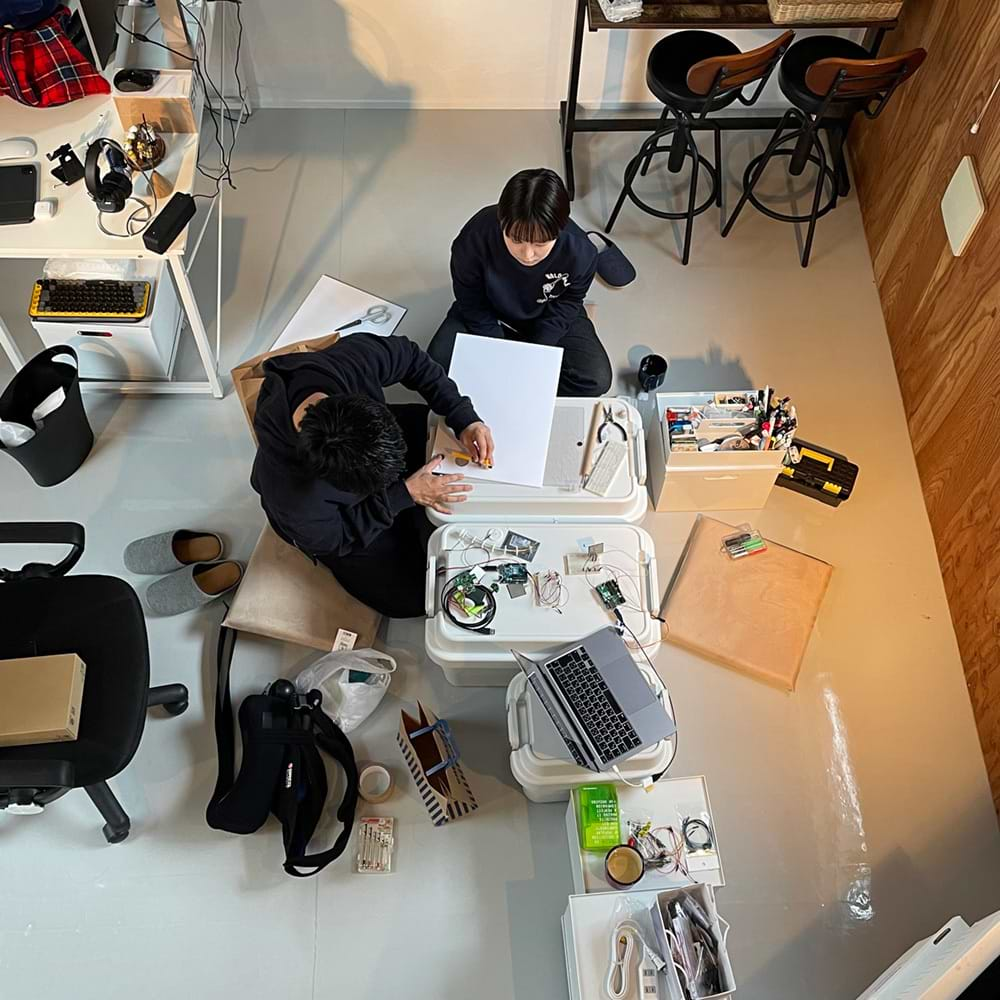
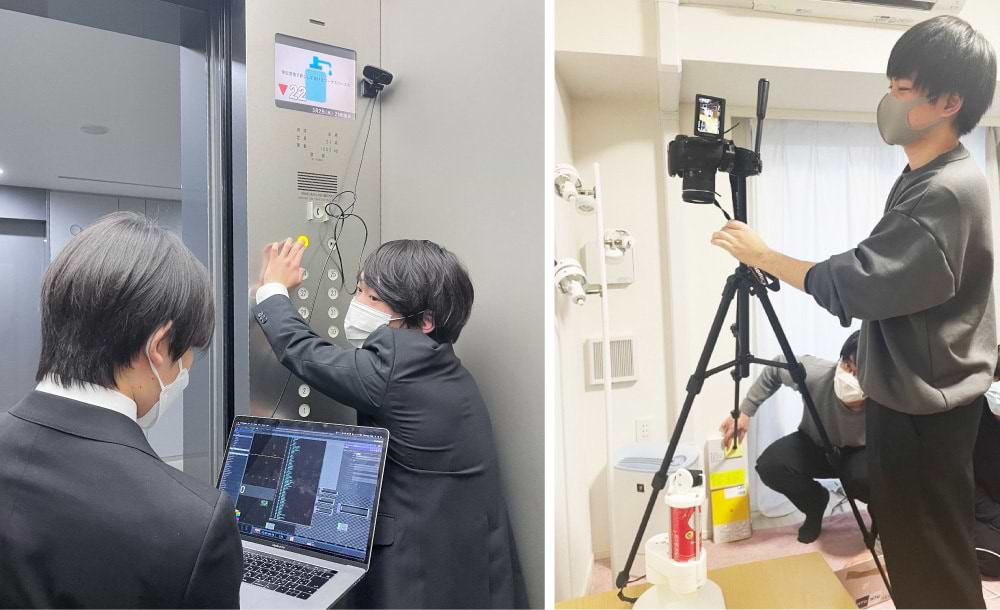
That summarizes the prototyping of the six teams. Finally, we’d like to introduce comments from hackathon participants who talked about the advantages of prototyping.
■Participating creators point out the advantages of prototyping:
- The image of the final product can be shared and issues can be specifically developed.
- The team feels motivated by seeing the prototype, and as a result, it drives the project.
- It’s easier to get feedback, such as, “We should try doing it this way.”
■Dentsu Lab Tokyo mentors also added the following comments:
“It was a wonderful mixed martial arts of creativity. The ideas based on the theme, the logo design and copy, and the presentations were all put together complementing conventional creativity with electronic circuits and software capabilities. If more teams like these emerge, we can expect to see more interesting work in the future.”
– Shintaro Murakami (Dentsu Lab Tokyo)
“Prototyping is sharing an image. It is equivalent to storyboards or a comprehensive graphic layout that are created for television commercials. Ideas that may not make it through with written proposals can be adopted right away. This hackathon showed that prototypes can drive the team forward.”
– Kazuyoshi Ochi (Dentsu Lab Tokyo)
“By using a prototype, you can communicate interesting aspects of the idea that could not be fully explained with a written proposal, you can make the idea shine brighter, and you can get more people on board who will help you. We received a huge response from the employees who watched the hackathon. This proves that prototyping generates empathy, and it can become a powerful tool that drives the project.”
– Ryonosuke Ono (Dentsu Lab Tokyo)
Ryonosuke Ono and Dentsu “Technology X Creative” team took the lead to plan and organize this hackathon.
The theme for the prototyping program was: “Solving issues and concerns that rookies may face.” Many of the creators who participated joined Dentsu in 2021 and have been working remotely, or transferred to the creative team in 2021. In other words, it was an attempt to solve their own compelling problem through prototyping.
That may be why many teams came up with solutions to overcome loneliness or lack of communication they felt from working remotely.
As the challenges and issues we face today become more diversified, the method of searching for solutions using technology to produce prototypes will become increasingly important. If you thought this prototyping method introduced here was interesting, don’t hesitate to contact Dentsu for more information!
